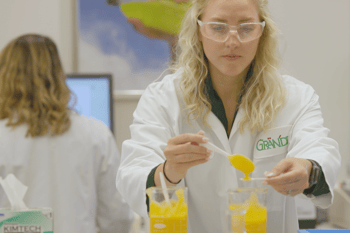
Seven in 10 (70%) U.S. consumers consider the dairy aisle a “must-stop” destination when shopping at their local grocery store, and nearly nine in ten (88%) say the products found there are likely to fit their lifestyles.
Those numbers are staggering – and, for some, surprising considering the barrage of marketing messages that suggest plant-based alternatives are dominating the food industry. Millions are spent advertising plant-based products each year yet, according to the latest data, the demand for real dairy, including whey protein dairy, is at an all-time high.
“Americans consumed more dairy products than ever in 2021.” USDA Economic Research Service
Not only are Americans continuing to consume dairy, global markets are seeing a healthy compound annual growth rate (CAGR) as well. While all global regions are seeing strong growth, Europe is the largest region in the dairy market, with rising health consciousness and increasing flexitarian diet trends among younger generations driving the growth. The fastest-growing region, however, is the African continent, followed by South America, Asia-Pacific and the Middle East.
At Grande Custom Ingredients Group, we’re not about to suggest that the emerging plant-based market isn’t a major player in the food industry, only that the demand for dairy isn’t lagging behind or taking a back seat. While the plant-based market is growing, the real dairy market is growing in stride.
The vast majority of shoppers still include dairy in their diets, and food and beverage manufacturers are keenly aware that they need to appeal to both consumer segments. Instead of taking an “either-or” approach, many manufacturers are pursuing plant-based products and those containing dairy ingredients.
In other words, formulators don’t need to pick sides.
While regular milk has seen a decline in consumption, other dairy products including butter, cheese, yogurt, and whey protein have surged. In fact, the global whey protein market is forecast to grow at a CAGR of 8.36% through 2027.
Whey Protein Dairy: Familiar, Functional, Favored
Overall, consumers want fewer processed foods and more “real food” from consumer packaged goods (CPG) brands. Formulators may not need to overhaul their entire product line to appeal to this growing consumer segment. Instead, many are identifying a select number of products in their portfolio to offer versions with simpler ingredient labels, similar to how some offer “free-from” versions of popular products.
A challenge for many plant-based versions is creating minimally processed products that have appealing flavors and mouthfeel. Incorporating plant-based ingredients into mainstream products often requires additional masking agents and texture modifiers, making for a longer ingredient list and potentially negating clean-label claims.
Another driving factor for the consumption of plant-based foods is the perceived impact on the environment. As consumers increasingly research their purchasing decisions, they’re becoming more aware that plant-based foods aren’t as sustainable as they thought.
RELATED: Sustainability Comparison: Whey Protein vs. Plant-Based Proteins
Various forms of whey protein concentrate (WPC), a natural dairy ingredient, can partially replace fresh cream, cheese, yogurt and other fresh dairy products, all while delivering health benefits, improved flavors and textures. Yet, formulators can still boast real dairy in their formulation with an ingredient that is familiar and trusted by consumers.
CASE STUDY: Controlled Study Results: Whey Protein Vs. Cream
More importantly, as a clean-label real food, whey protein helps formulators produce CPGs with minimal ingredients. In particular, Grande Custom Ingredients Group is a whey manufacturer that uses zero chemical modifications in its production process, unlike some plant-based ingredient manufacturers and commodity whey protein producers. Our products have clean flavor profiles and help to enhance flavors and textures. Formulators don’t need to “hide” any off flavors or unsavory textures by adding unwanted ingredients, also helping to reduce inventory SKUs.
To put it simply, whey protein isn’t the newest shiny object in the food industry; it’s tried and true, and familiar to consumers. Yet, not all whey protein producers are the same. Let Grande Custom Ingredients Group show just how functional our products are. Discover how to maintain clean labels and improve flavor, texture and nutrition while still using wholesome real dairy. Use whey protein concentrate to partially replace cream, cheese, cheese powder, yogurt and other dairy ingredients in your formulations to deliver products consumers love. Contact us today.


.webp?width=350&height=235&name=Blog_Label-900x600%20(1).webp)

